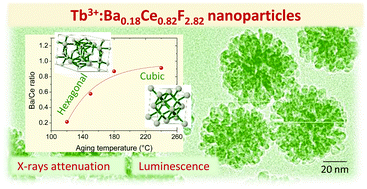Ask for a reprint
email :
2018
ACL
|
D.González-Mancebo, A.Becerro*, C.Genevois, M.Allix, A.Corral, A.Parrado-Gallego, M.Ocaña, 'Structural, optical and X-ray attenuation properties of Tb3+:BaxCe1-xF3-x (x=0.18 – 0.48) nanospheres synthesized in polyol medium', Dalton Trans. 47 8382-8391 (2018) doi:10.1039/c8dt01202d
Uniform Ba0.18Ce0.82F2.82 nanospheres have been obtained after aging at 120 ºC for 20
hours a solution of barium and cerium nitrates and sodium tetrafluoroborate in a mixture
of ethylene glycol and water. The spheres diameter could be tailored from 65 nm to 80
nm by varying the NaBF4 concentration while maintaining their colloidal stability in
aqueous suspension. Increasing aging temperature led to a phase transformation from
hexagonal to cubic symmetry and to a concomitant increase of the Ba/Ce ratio, which
reached a value close to the nominal one (50/50) at 240ºC. The same method was
successful to obtain Tb3+-doped nanospheres with homogeneous cations distribution and
the same morphological features as the undoped material. An intense green emission
was observed after excitation of the Tb3+-doped samples through the Ce3+-Tb3+ energy
transfer (ET) band. The ET efficiency increased with increasing Tb content, the
maximum emission being observed for the 10% Tb-doped nanospheres. Aqueous
suspensions of the later sample showed excellent X-ray attenuation values that were
superior to those of an iodine-based clinically approved contrast agent. Their
fluorescence and X-ray attenuation properties make this material a potential dual
bioprobe for luminescence bioimaging and X-rays computed tomography.
|

|